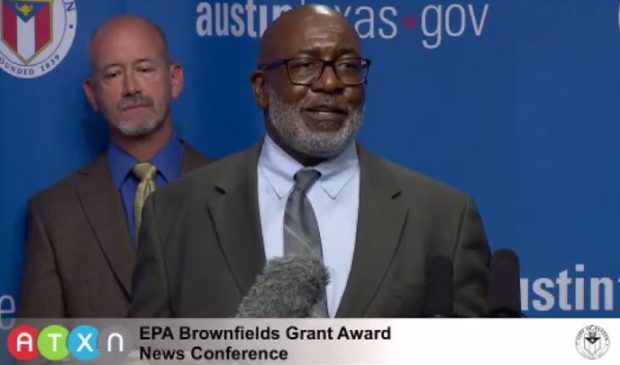About the Author
Chad Swiatecki is a 20-year journalist who relocated to Austin from his home state of Michigan in 2008. He most enjoys covering the intersection of arts, business and local/state politics. He has written for Rolling Stone, Spin, New York Daily News, Texas Monthly, Austin American-Statesman and many other regional and national outlets.
Newsletter Signup
The Austin Monitor thanks its sponsors. Become one.
Most Popular Stories
- Austin-Bergstrom International Airport announces new flight service while anticipating capacity cuts
- A once-banned type of building is back in favor – and the Planning Commission approves
- City facing a $33 million deficit for 2026
- East Austin’s ‘wishbone’ bridge takes shape as concrete beams almost span Lady Bird Lake
- SOS suing state agency over failure to provide information on MoPac expansion
-
Discover News By District

Brownfield grants provide $300,000 to clean up East Austin
Thursday, June 1, 2017 by Chad Swiatecki
Potential brownfield properties in East Austin will be eligible for remediation efforts in the coming years thanks to two grants from the federal Environmental Protection Agency totaling $300,000. The grants, which were announced Wednesday, will be available for use beginning October 1, when the city’s current three-year grant cycle from the EPA concludes.
The money will pay for two phases of assessment to determine if a site has hazardous materials in its ground or water or in an existing building, and can also be used to fund creation of a cleanup plan and the sometimes decades of reporting needed for the potentially environmentally dangerous sites.
Christine Whitney, manager of the city’s Brownfields Revitalization program, said the money could pay for testing and other work on more than a dozen properties, depending on the costs associated with cleanup plans and other steps needed once testing begins. Sites will be selected based on an application process on a first-come, first-served basis, with the application available on the city department’s website.
In the press conference announcing the grants, Whitney and Mayor Steve Adler said the grants will be focused on the Eastern Crescent of Austin because of the region’s history of relaxed zoning regulations that allowed factories and other potentially hazardous uses near where the city’s minority populations were moved to beginning in the 1920s.
Whitney said applications will be judged based on a project’s expected benefit to the existing residents, with factors such as affordable housing, job creation and park space figuring into the evaluations.
“There is environmental justice that needs to happen because of the history of minority relocation, and we’re trying to alleviate that for people who have suffered,” she said. “As part of that we need to create a situation where those people are able to remain and get a chance to thrive in that area as these sites are improved.”
It is expected that a portion of properties tested will be put back into active economic use, with Adler citing estimates that every dollar of brownfield investment unlocks another $16 in eventual jobs and economic opportunities. Since 2006 Austin has received $1.7 million in brownfield funds, the most recent allocation coming in 2014 with the award of $400,000.
Adler said the grants will help continue the city’s practice of turning former brownfield sites into community assets such as the Mabel Davis District Park, the African American Cultural and Heritage Facility and the Guadalupe-Saldana Subdivision.
“These grants are important to our city as we seek to provide and restore economic justice and economic equity to all parts of our city,” he said. “It allows us to create affordable housing. It allows us to preserve the history and the culture of the Eastern Crescent.”
Whitney said one possible site that could receive testing and other brownfield work is the former Brackenridge Hospital site on I-35, which has been designated for redevelopment into a mixed-use property that will include affordable housing. She said officials with Central Health, the nonprofit agency that controls that property, have expressed a desire to utilize the funds since there is a high likelihood of hazardous materials remaining there.
Asked about the uncertainty of future EPA funding under the administration of President Donald Trump, she said both Republicans and Democrats tend to view brownfield efforts favorably because they combine economic and environmental concerns into one program. Also in their favor is the fact that former Oklahoma Attorney General Scott Pruitt, now the head of the EPA, has a track record of supporting brownfield projects and funding.
This story has been corrected to reflect the fact that Central Health has not yet identified affordable housing as a component of the project. Photo courtesy of ATXN: Sam Coleman, acting regional administrator for the U.S. Environmental Protection Agency Region 6.
The Austin Monitor’s work is made possible by donations from the community. Though our reporting covers donors from time to time, we are careful to keep business and editorial efforts separate while maintaining transparency. A complete list of donors is available here, and our code of ethics is explained here.
You're a community leader
And we’re honored you look to us for serious, in-depth news. You know a strong community needs local and dedicated watchdog reporting. We’re here for you and that won’t change. Now will you take the powerful next step and support our nonprofit news organization?





